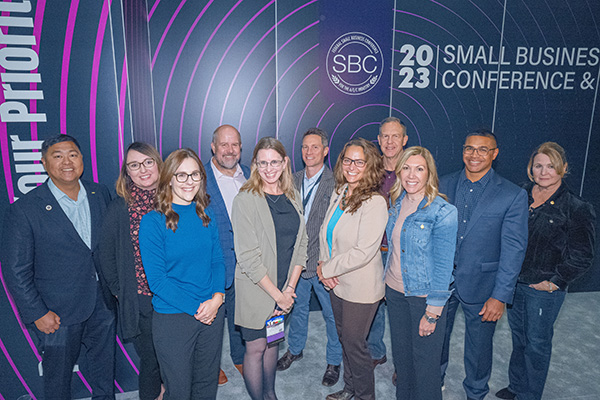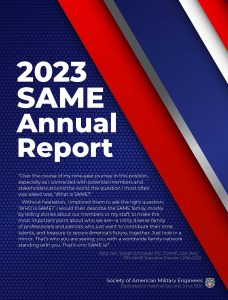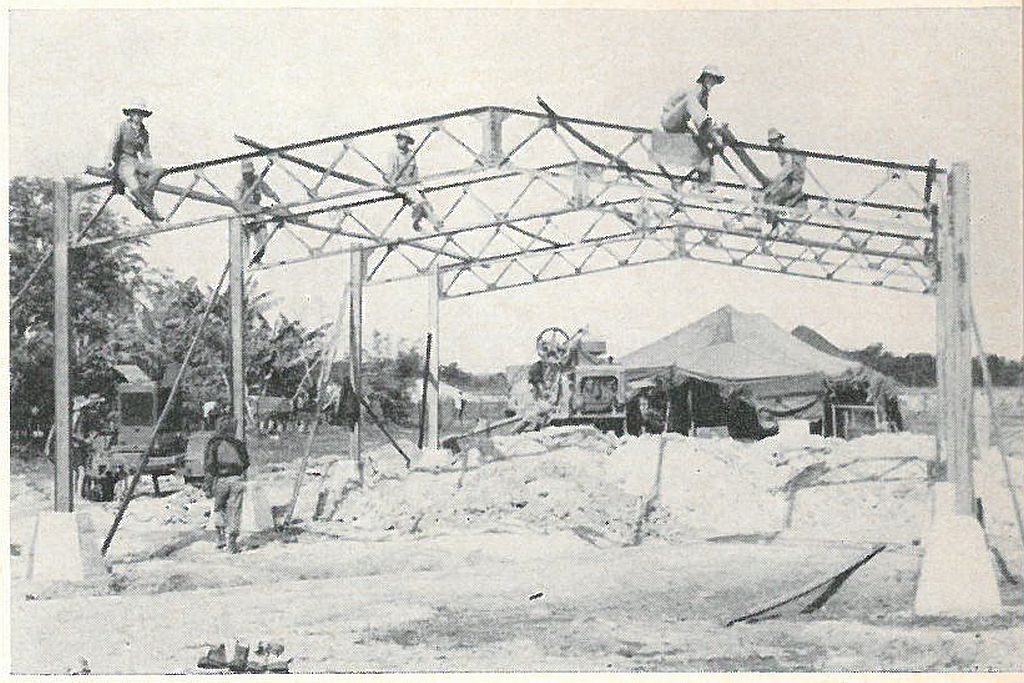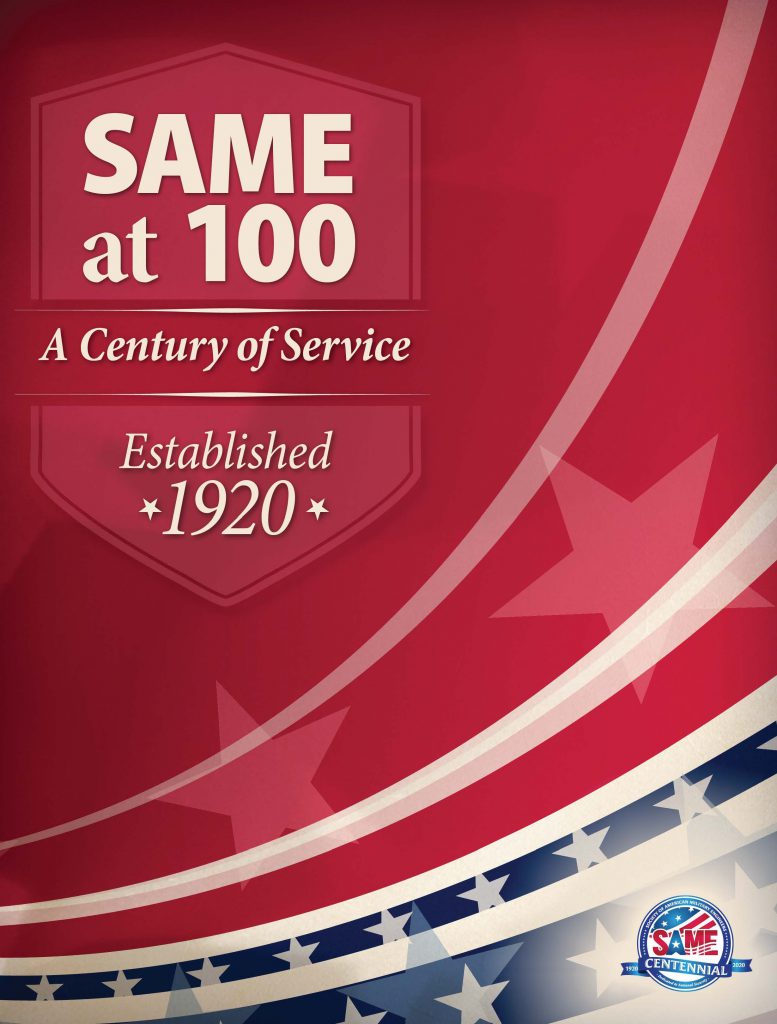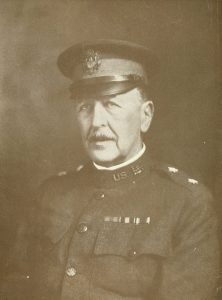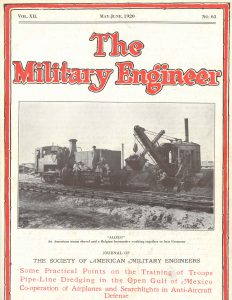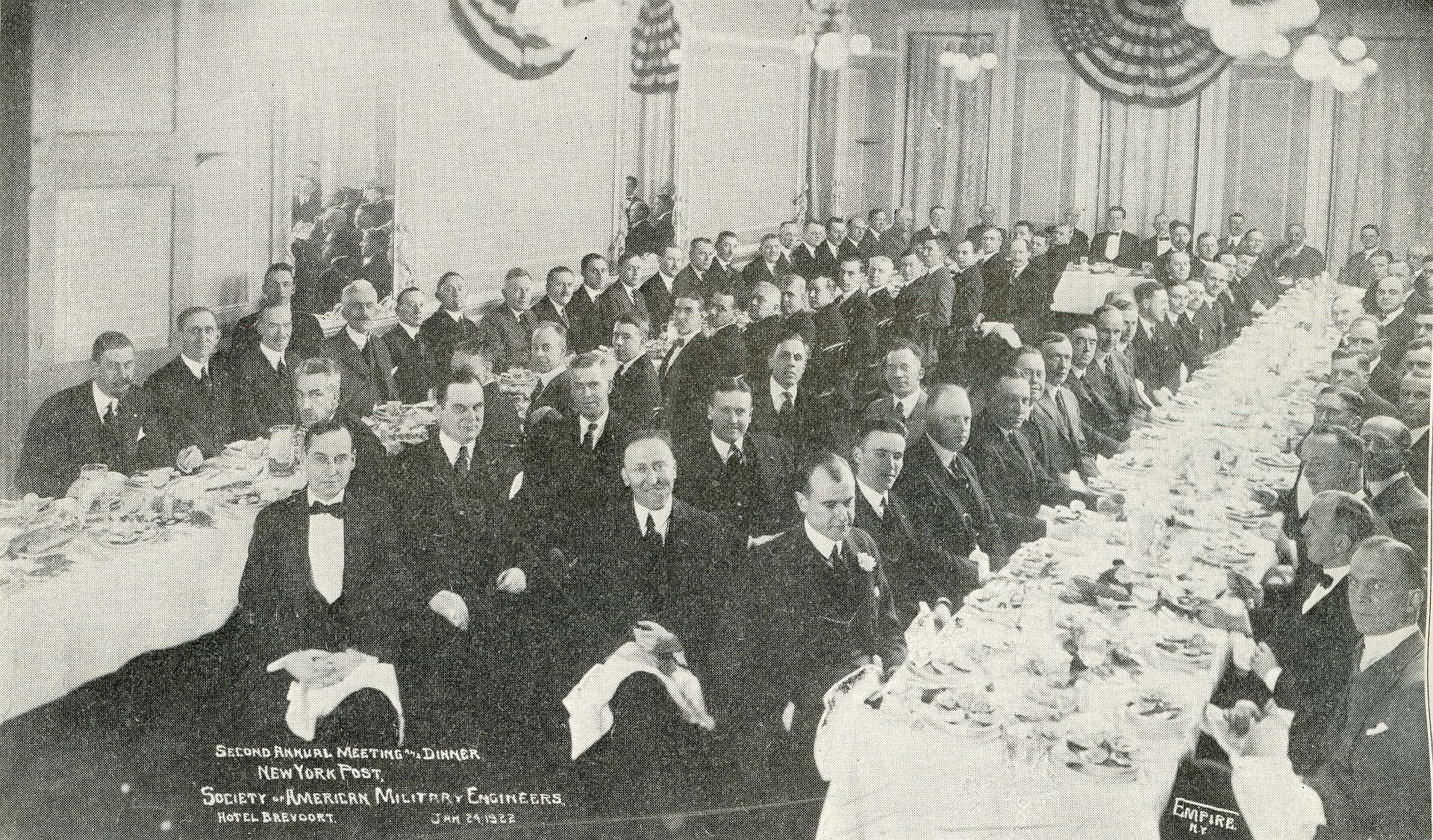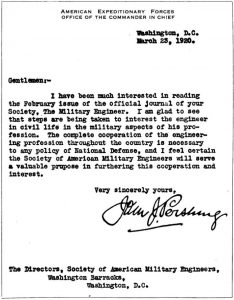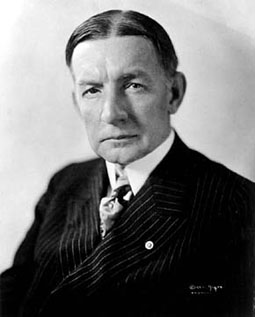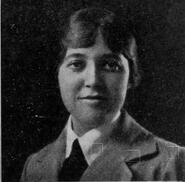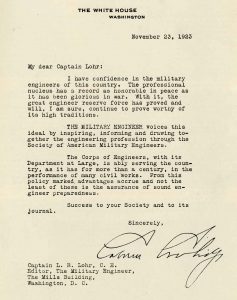The History of SAME

Less than 14 months after the Armistice of 11 November 1918 and the end of The Great War, the Society of American Military Engineers was founded in January 1920. Dedicated to “patriotism and national security,” this new “association of engineers” sought to bring engineering professionals from the public and private sectors together to ensure that never again would our nation’s engineering community enter a conflict as unprepared as it did in 1917.
When the United States joined World War I, engineers numbered 256 officers and 2,228 soldiers. At the end of the war, there were 10,886 officers and 292,300 men in the Engineering Department of the United States. The demand for engineering skills was significant. Those who had been called to serve, drawn from their professional lives in America’s cities and towns, and those already in the regular service, knew that to capture lessons learned and to maintain the relationships established “over there” they would need a way to stay connected. SAME became that way.
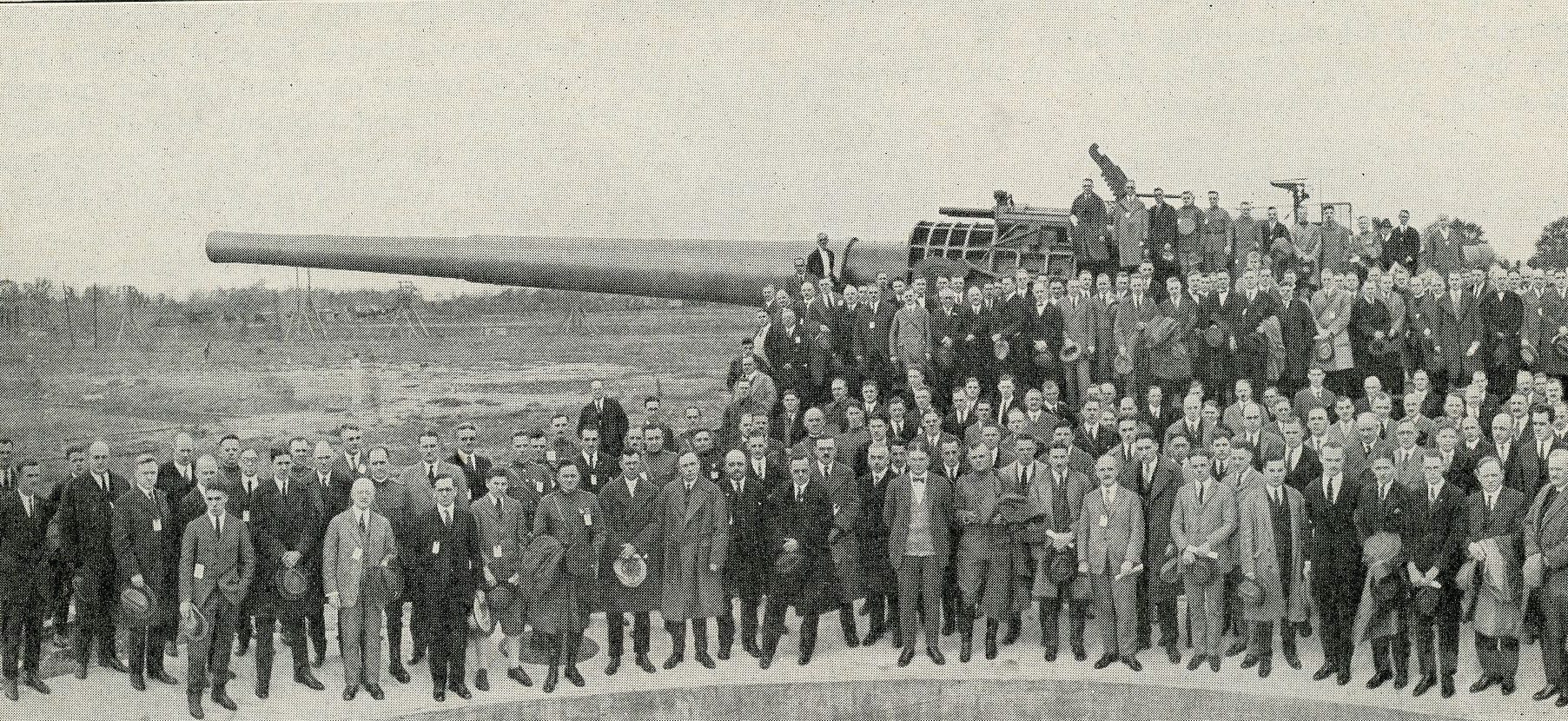
We are establishing at this time a Society of American Military Engineers. This society will serve no selfish ends. It is dedicated to patriotism and national security. Its objects are, in brief, to promote solidarity and co-operation between engineers in civil and military life, to disseminate technical knowledge bearing upon progress in the art of war and the application of engineering science thereto, and to preserve and maintain the best standards and traditions of the profession, all in the interests of patriotism and national security.
The Military Engineer, January-February 1920
As a young organization, SAME grew from those experiences in “The War to End All Wars” when thousands of engineers in civil life were called to duty in uniform. Upon their return home, many feared the collective knowledge and the cooperation between the public and private sectors that proved vital to combat success would be lost.
Together, industry and military leaders vowed to capitalize on the technical lessons and camaraderie shared during their battlefield experiences, and create an organization through which the national engineering community could ensure a preparedness and readiness for the nation’s civil and military needs. And while the organization has grown and evolved over the last 100 years, its purpose has not changed. SAME is the premier engineering association in the United States bringing together public and private sector professionals to build connections, share lessons learned, and develop solutions to strengthen our national security.
A Society is Born
In 1919, Maj. Gen. William M. Black, USA, U.S. Army Chief of Engineers, appointed a nine-officer board to consider the formation of an “association of engineers” that would preserve and expand upon connections formed in war and promote the advancement of engineering and its related professions across both government and civil life. Early in 1920, the first SAME Posts were founded, providing former colleagues and new associates with opportunities to connect face-to-face and establishing a network of relationships across the country in support of national security.
Membership in SAME grew rapidly. By September 1920, the number of members had surpassed 3,500. Many notable national leaders were early members of SAME, including Maj. Gen. Mason Patrick, who was Chief of American Expeditionary Force’s Air Service in World War I; then-Superintendent of the U.S. Military Academy, Douglas MacArthur; and Charles Dawes, who in 1928 would serve simultaneously in two defining leadership positions: President of SAME and Vice President of the United States of America.
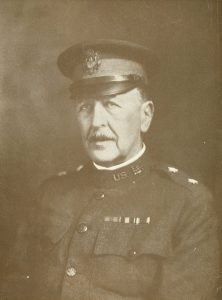
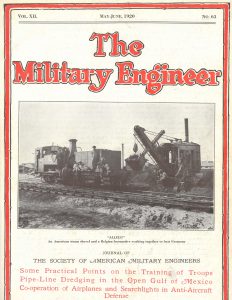
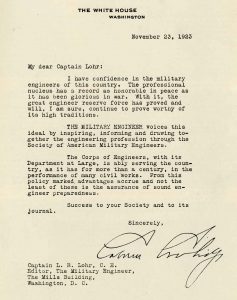
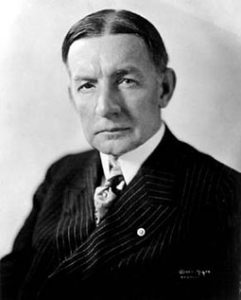
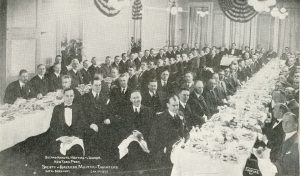
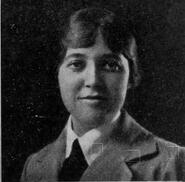
SAME Century Book
Published in 2021, The Second Century Begins: Preparing for the Future by Building on the Past is the award-winning* publication marking the first 100 years of the Society of American Military Engineers. Filled with a combination of unique archival material from the past century of engineering history and an unprecedented look at tomorrow, this book is a never-before-attempted survey of SAME’s past, present, and future.
Dive into the compelling stories, unique perspectives, and rare insights into the sweeping contributions of members over the years. The perfect commemoration of SAME’s first century—and the perfect foundation for our second one!
Price is $38.95 with free shipping: includes all CONUS addresses (including APO/FPO); overseas orders, the cost is $38.95 plus shipping.
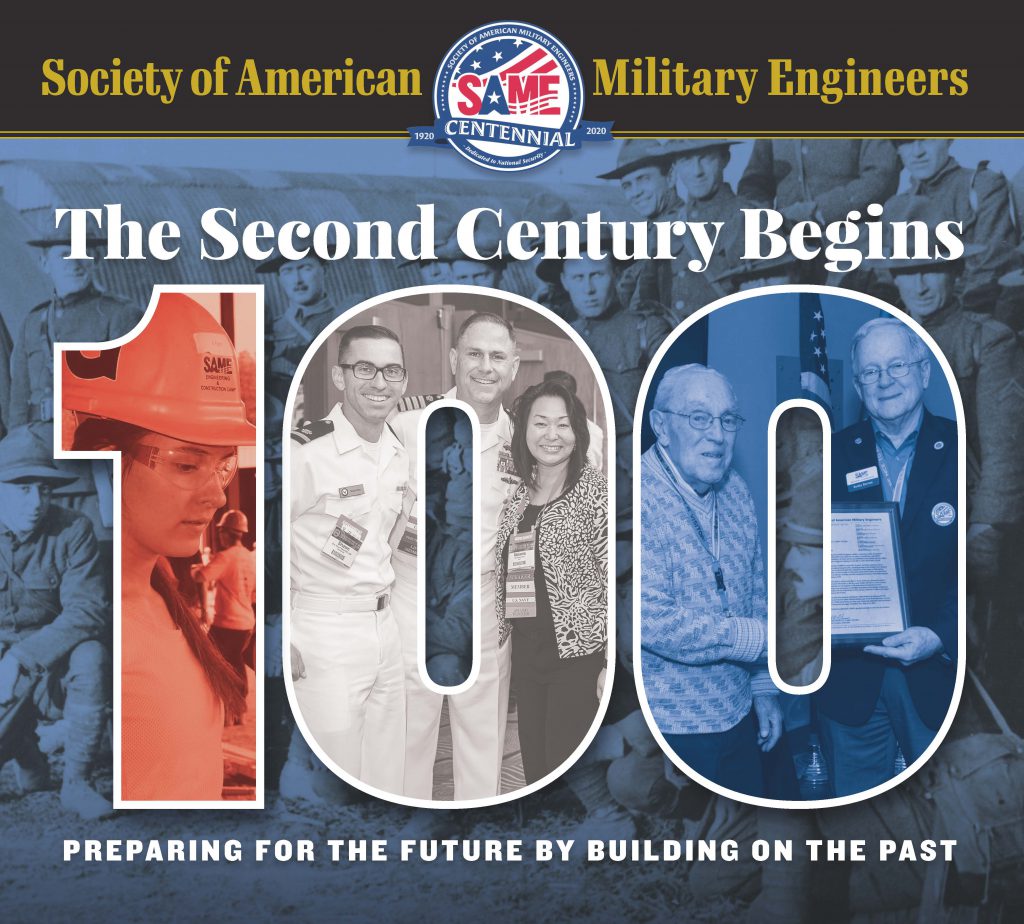
Central to the establishment and growth of SAME was The Military Engineer magazine, which, throughout its history, has served as a professional journal dedicated to promoting and advancing engineering for national security. The Military Engineer was launched under its current masthead in 1920 (after previously being published as Professional Memoirs, a Corps of Engineers publication) and immediately carried the message of the new “association of engineers” and was a vital tool in communicating with engineers across the country and helping establish the Post network, which became the bedrock of SAME.
The Military Engineer has celebrated the efforts of military engineers during some of the history’s most significant armed conflicts, including two World Wars, Korea, Vietnam, and the Global War on Terror. It has detailed the greatest feats of modern engineering, such as the Panama Canal, the Hoover Dam, and the Manhattan Project. The Military Engineer has followed the trends of military engineering from the early development of our nation’s transportation infrastructure through Cold War-era construction and the birth of computer-aided design to the current era of sustainable development, infrastructure resilience, and military base realignment.
For nearly a century, SAME members have been at the forefront of our nation’s greatest engineering contributions—the development of nuclear energy, the successes of World War II, the national highway system, and America’s unparalleled water infrastructure network, sanitation, and public health engineering advancements, the projection of air and sea power, space exploration, environmental stewardship, and humanitarian support to global disasters. And today, SAME members continue to support our ongoing 21st Century challenges, including the war of terror, cyber security, and the effects of climate change.
“I have been a member of this Society since its inception. Its span of years has seen the most remarkable rate of development of civilization the world has ever witnessed. This accomplishment has synchronized with some of the most acute perils the human race has ever known and overcome. In both categories the engineer has distinguished himself and his profession. Not only in what he has done but in what he has prevented from being done, he has established himself as one of the basic pillars of modern society. I have belonged to many distinguished groups but none in which I have a greater sense of honor than in the Society of American Military Engineers.”
General of the Army Douglas MacArthur, SAME Charter Member
Leading Collaboration
SAME, as it celebrated its 100th anniversary in 2020, has grown alongside its members. The organization now boasts a leading program of conferences, workshops, symposiums, and professional development and networking opportunities. SAME’s membership comprises nearly 30,000 professionals representing the uniformed services as well as numerous state, local, and federal government agencies, nonprofit associations, academic institutions, and private sector firms—all working to guide the future of the A/E/C profession and its contributions to the protection of our nation.
The Society’s mission, to lead collaboration in support of our national security priorities through a commitment to advancing three interdependent strategic goals (Drive Partnership, Deliver Solutions, and Develop People), unites public and private sector individuals and organizations from across the architecture, engineering, construction, environmental and facility management, cyber security, project planning, contracting and acquisition, and related disciplines in support of national security.
SAME is led by a volunteer Board of Direction that comprises six National Officers (including President, President-Elect, Past President, and three Vice Presidents), 18 Regional Vice Presidents, the Chairs of the Communities of Interest, as well as 12 Elected Directors who serve three-year terms and are elected in groups of four annually. The SAME National Office, overseen by an Executive Director and a professional staff, is located in historic Old Town Alexandria, Va.
In 2016, the SAME Foundation was established to support the professional growth and development of the next generation of military, government civilian, and A/E/C industry leaders. By supporting the development of young professionals and creating opportunities that inspire America’s youth to pursue a career in STEM, the establishment of the SAME Foundation is a major step toward achieving the 2020 SAME Strategic Plan goals and objectives. The SAME Foundation is building on a strong philanthropic legacy, investing in programs that will make an impact on fostering engineering leadership for the nation. In 2019, SAME, with the support of the SAME Foundation, began a national Leader Development Program that serves to cultivate leadership from within the membership to support the 21st century needs of the nation and the A/E/C profession
Getting Connected
SAME consists of more than 100 Posts as well as Student Chapters and Field Chapters around the world. Posts are the bedrock of SAME—enabling people to get connected on the local level where the impacts of solutions and lessons learned can be implemented most effectively. It is SAME’s goal to be a Society of Posts that are relevant locally while contributing to a cohesive national direction. Posts are assets in their communities. They inspire students toward STEM careers, mentor young professionals, support veterans, promote resilience and help identify and resolve infrastructure-related challenges. In 2018, collectively, SAME Posts set a new record in awarding over $1.1 million in scholarships and 70 held a joint event with another association.
Becoming Involved
The Society also offers a number of avenues to become involved at the national level, including through the Committees & Councils, the Academy of Fellows, and our world-class Engineering & Construction Camps, which are held in partnership with the military services.
SAME’s Communities of Interest offer members a chance to engage with other professionals focused on a particular community of interest or demographic within the A/E/C industry. In addition to monthly and quarterly calls and webinars, and assisting with the national awards program, the Committees & Councils are a leading source for developing the education and training roadmap for major SAME events, national webinars and other professional development opportunities, including those held in conjunction with SAME’s strategic partners.
The Academy of Fellows recognizes those members who have rendered dedicated and outstanding service to the Society, military engineering, and the A/E/C profession. SAME has bestowed the title of Fellow on select members since 1972; in 1995 an academy was founded to formally acknowledge these distinguished individuals for their dedication to SAME and the A/E/C profession. Today, there are more than 800 members of the Academy of Fellows. Fellows are instrumental in helping the Society carry out mentoring programs, leader development initiatives, STEM outreach, and leading their local Posts.
Each summer, SAME hosts week-long camps geared towards inspiriting youth to pursue a career in engineering and consider the opportunities of serving as a military engineer. SAME has long been advancing events and activities and offering scholarships designed to excite students to become engineers. For over 20 years, in collaboration with the military services, SAME’s Engineering & Construction Camps have helped support high school students who excel in math, science, and technology and are interested in pursuing engineering, architecture, or related fields in college.
Staying Informed
From a communications standpoint, SAME’s media products seek to document lessons learned, share best practices, highlight members, and showcase trends that matter to the A/E/C industry and joint engineering community. Through The Military Engineer magazine, SAME Newsroom, research reports, the Company Directory, and a vibrant collection of digital media platforms, including the Real TiME e-newsletter, SAME members can stay informed of all that is happening across the A/E/C industry and the military engineering community.
Growing Professionally
It is people who innovate, lead, solve and inspire. SAME is committed to supporting members’ efforts enhance their careers to help sustain the future of the profession. From graduate-level technical presentations at national events to on-demand educational webinars to mentoring programs for young leaders to an online Career Center, SAME offers numerous ways to grow professionally, whether you are a junior officer, an enlisted service member, a mid-career manager, or a senior executive. SAME also offers credentialing support, including reimbursement programs, to enable Young Members to attain the licenses, credentials, and certifications necessary to propel their career forward.
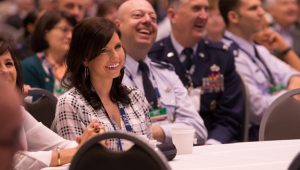
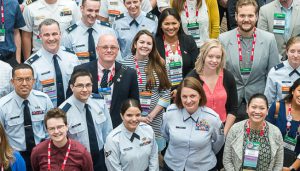
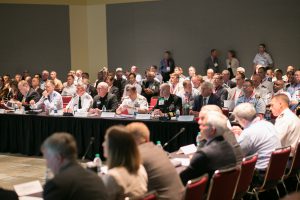
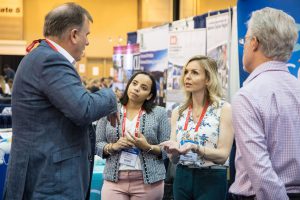

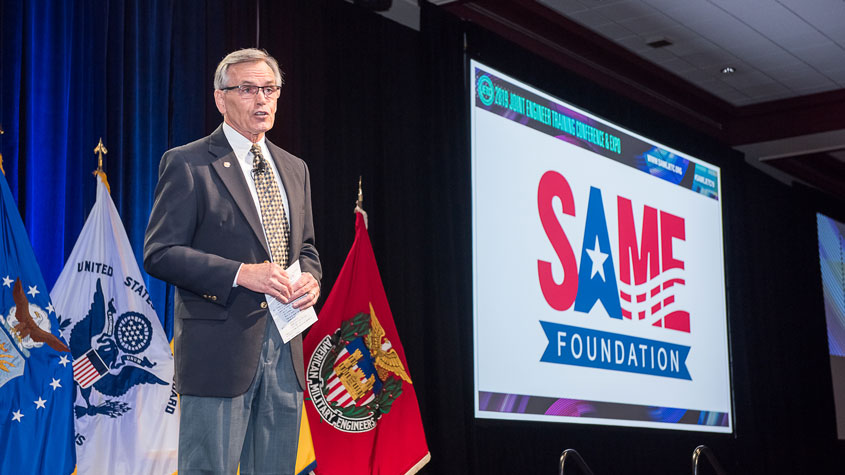
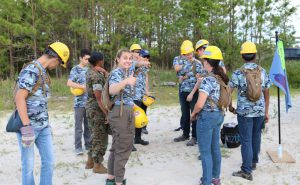
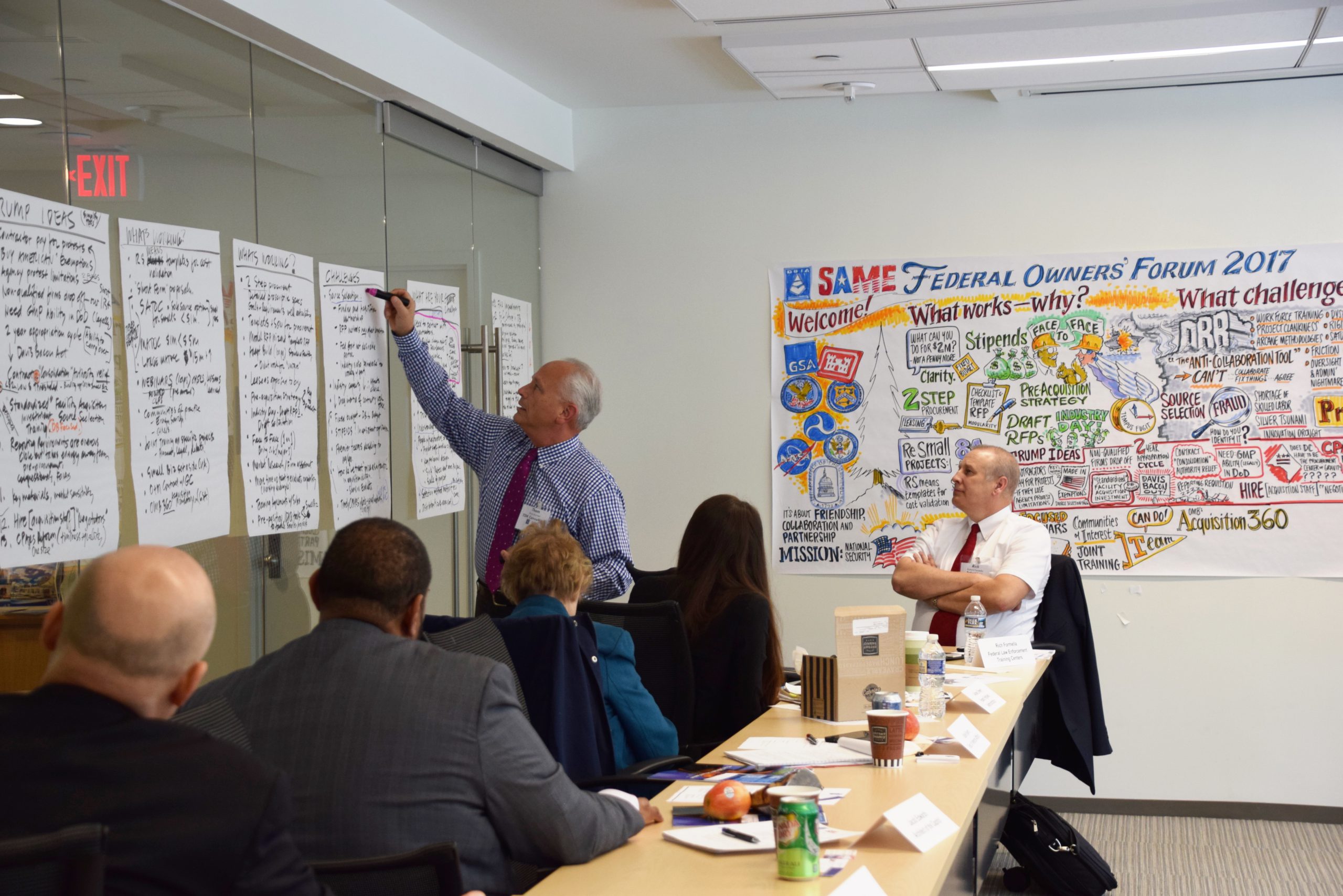
2020 & Our Second Century
As the Society looked ahead to its second century of service, five lines of effort materialized that demonstrate SAME’s suitability to continue to lead efforts to address the infrastructure-related challenges facing America. Their importance has been influential as SAME moved forward in achieving its mission and vision and in implementation as of 2025 of the SAME 2030 Strategic Plan and its goals of Drive Partnership, Deliver Solutions, and Develop People.
Strengthening Industry-Government Engagement
This line of effort is the bedrock upon which SAME was formed. Our Industry-Government Engagement Plan is producing tangible results at the national and Post levels. Notably, our efforts to bring the engineering services together with partners such as the Lean Construction Institute, Associated General Contractors of America, Construction Management Association of America, and Design-Build Institute of America, along with several Sustaining Member firms, has produced a model that is already being used to bring project partnering back. Moreover, our Federal Small Business Conference for the A/E/C Industry, which in 2018 set an attendance record for the fifth straight year, is rapidly becoming the “one-stop” market research event for government and industry.
Building and Sustaining Resilient Communities
The challenges of the 21st Century require new thinking; innovative materials and techniques; bold leadership; better lifecycle management; and a keen ability to plan for and operate in an environment of uncertainty, such as consideration of emerging trends like mega regions. The population surge of the industrial age led to the growth of cities. How will we cope with the exponential growth of the world’s population (which has doubled in just the last 70 years) against a backdrop of greater natural disaster events? These challenges will directly impact national security for decades to come and can only be solved collaboratively.
Developing Leaders for the Profession
Developing leaders who can lead collaboration on the basis of trust will be key in our next century. The SAME Foundation, started in 2016, established its compelling purpose to be “fostering engineering leadership for the nation.” In a relatively short time, it has supported many leadership development efforts and of special note, has underwritten the development of a national Leadership Development Program that commenced in May 2019. The Camps Program, Communities of Interest, Academy of Fellows, and board positions nationally and locally are just a few of the many leadership development opportunities that exist in SAME.
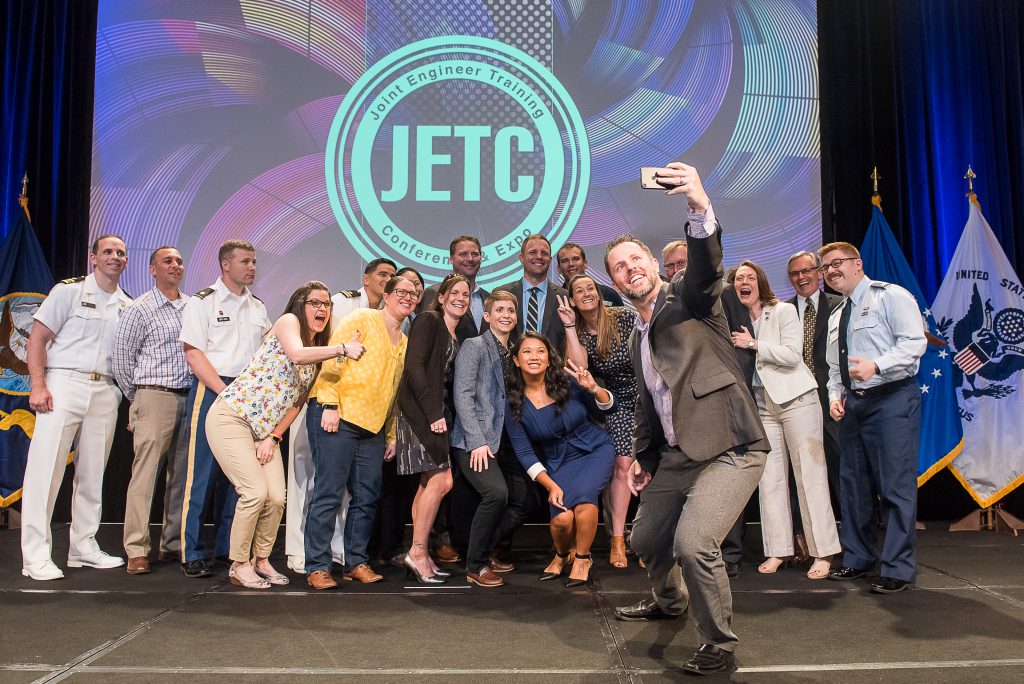
Enriching the STEM Pipeline for the Nation
The worldwide shortage of STEM professionals is a serious issue, with demands only exacerbated by our aging infrastructure at the same time other nations are investing heavily in theirs. Another challenge is to ensure that we break the cyclic nature of our capacity. It was not that long ago when in the late 1980s many potential STEM professionals turned away because of the shortage of related jobs. We need to maintain the pipeline, not just fill it in the short term.
Preparing Veterans and Servicemembers for the A/E/C Industry
The last 20 years of war have produced a generation of warriors who, like their counterparts during the major conflicts before, deserve our support. As one example, our Credentialing Committee has led an effort the last few years that contributed to the military services’ work to transform their construction trade-related training curricula to mirror the skills required for private sector certification. We are now expanding that effort to support military and civilian members who are not engineers.
“I am glad to see that steps are being taken to interest the engineer in civil life in the military aspects of his profession. The complete cooperation of the engineering profession throughout the country is necessary to any policy of National Defense, and I feel certain the Society of American Military Engineers will serve a valuable purpose in furthering this cooperation and interest.”
General of the Armies John Pershing, 1920
An Enduring Purpose
A Timeline of Our First Decade
The Society has successfully passed through the period in the experiences of similar organizations when the question of continued existence is always in doubt. An organization starts with flattering prospects; it prospers for a while; then a period of reaction occurs, and the initial enthusiasm is chilled. The records show that our own Society has triumphed over all these dangers. it is because those who were responsible for the organization of the Society built it on a sound foundation, with living and enduring principles as its actuating spirit.
William Barclay Parsons, 1922
SAME Presidents: 1920-Today
1920 Maj. Gen. William Black, USA (Ret.)
1921 Maj. Gen. William Black, USA (Ret.)
1922 Col. G.A. Youngberg, USA
1923 Maj. Gen. W.C. Langfitt, USA (Ret.)
1924 Maj. Gen. Lansing Beach, USA
1925 Maj. Gen. Harry Taylor, USA
1926 Brig. Gen. Cornelius Vanderbilt, USAR
1927 Maj. Gen. Edgar Jadwin, USA
1928 Brig. Gen. Charles Dawes, USA (Ret.)
1929 S.M. Felton
1930 Maj. Gen. Mason Patrick, USA (Ret.)
1931 Col. F.G. Jonah, USA (Ret.)
1932 Brig. Gen. Herbert Deakyne, USA (Ret.)
1933 Col. E.A. Gibbs, USA (Ret.)
1934 Col. C. McD. Townsend, USA (Ret.)
1935 Col. Albert Perkins, USA (Ret.)
1936 Brig. Gen. Charles Kutz, USA (Ret.)
1937 Rear Adm. R.E. Bakenhus, CEC, USN
1938 Maj. William Bowie, USAR (Ret.)
1939 Brig. Gen. G.B. Pillsbury, USA (Ret.)
1940 Col. J. Monroe Johnson, USA (Ret.)
1941 Rear Adm. Ben Moreell, CEC, USN
1942 Maj. Gen. Julian Schley, USA (Ret.)
1943 Frederick Hall Fowler
1944 Vice Adm. R.R. Waesche, USCG
1945 Brig. Gen. W.H. Rose, USA (Ret.)
1946 Rear Adm. Henry Williams, USN (Ret.)
1947 Maj. Gen. Carl Gray Jr., USA (Ret.)
1948 Maj. Gen. David McCoach Jr., USA (Ret.)
1949 Rear Adm. J.J. Manning, CEC, USN
1950 Lt. Gen. R.A. Wheeler, USA (Ret.)
1951 Rear Adm. Leo Otis Colbert, USCGS (Ret.)
1952 John Volpe
1953 Brig. Gen. Dwight Johns, USA (Ret.)
1954 Maj. Lenox Lohr, USA (Ret.)
1955 Rear Adm. Joseph Jelley, CEC, USN
1956 Maj. Gen. James Newman Jr., USAF (Ret.)
1957 Rear Adm. H. Arnold Karo, USCGS
1958 Maj. Gen. Emerson Itschner, USA
1959 Vice Adm. W. Orme Hiltabidle, CEC, USN (Ret.)
1960 Maj. Gen. Augustus Minton, USAF
1961 Col. Walker Cisler, USA (Ret.)
1962 Rear Adm. Eugene Peltier, CEC, USN (Ret.)
1963 Lt. Gen. W.K. Wilson Jr., USA
1964 Maj. Gen. Robert Curtin, USAF
1965 Rear Adm. Peter Corradi, CEC, USN
1966 Rear Adm. John Oren, USCG
1967 Lt. Gen. William Cassidy, USA
1968 Rear Adm. Alexander Husband, CEC, USN
1969 Lt. Gen. Frederick Clarke, USA
1970 Maj. Gen. Guy Goddard, USAF
1971 Rear Adm. Walter Enger, CEC, USN
1972 Donald Bentley
1973 Brig. Gen. H.O. Johnson Jr., USAF
1974 Lt. Gen. William Gribble Jr., USA
1975 Rear Adm. A.R. Marschall, CEC, USN
1976 Maj. Gen. Robert Thompson, USAF
1977 Seymour Greenfield
1978 Lt. Gen. John Morris, USA
1979 Rear Adm. Donald Iselin, CEC, USN
1980 Maj. Gen. William Gilbert, USAF
1981 Louis Riggs
1982 Lt. Gen. Joseph Bratton, USA
1983 Rear Adm. William Zobel, CEC, USN
1984 Maj. Gen. Clifton Wright Jr., USAF
1985 Rear Adm. Kenneth Wiman, USCG
1986 Rear Adm. John Paul Jones Jr., CEC, USN
1987 Lt. Gen. E.R. Heiberg III, USA
1988 Maj. Gen. George Ellis, USAF
1989 Rear Adm. Benjamin Montoya, CEC, USN
1990 Maj. Gen. Joseph Ahearn, USAF
1991 Lt. Gen. Henry Hatch, USA
1992 Rear Adm. David Bottorff, CEC, USN
1993 Maj. Gen. James McCarthy, USAF
1994 Rear Adm. Jack Buffington, CEC, USN
1995 Lt. Gen. Arthur Williams, USA
1996 Maj. Gen. Eugene Lupia, USAF
1997 Rear Adm. David Nash, CEC, USN
1998 Lt. Gen. Joe Ballard, USA
1999 Rear Adm. Louis Smith, CEC, USN
2000 Maj. Gen. Earnest Robbins II, USAF
2001 Roger Wozny
2002 Lt. Gen. Robert Flowers, USA
2003 Rear Adm. Michael Johnson, CEC, USN
2004 Maj. Gen. L. Dean Fox, USAF
2005 Rear Adm. Michael Loose, CEC, USN
2006 Lt. Gen. Carl Strock, USA
2007 Maj. Gen. Delwyn Eulberg, USAF
2008 Rear Adm. W. Gregory Shear Jr., CEC, USN
2009 Lt. Gen. Robert Van Antwerp, USA
2010 Maj. Gen. Timothy Byers, USAF
2011 Rear Adm. Christopher Mossey, CEC, USN
2012 Anthony Leketa, SES (Ret.)
2013 Rear Adm. Gary Engle, USN (Ret.)
2014 Col. John Mogge, Ph.D., USAF (Ret.)
2015 Jane Penny
2016 Capt. Michael Blount, USN (Ret.)
2017 Col. Sal Nodjomian, USAF (Ret.)
2018 Col. Marvin Fisher, USAF (Ret.)
2019 Lt. Col. Wendell Barnes, USA (Ret.)
2020 Heather Wishart-Smith
2021 Rear Adm. Mark Handley, P.E., USN (Ret.)
2022 Cindy Lincicome
2023 Col. Charlie Perham, USAF (Ret.)
2024 Sharon Krock, SPWS, F.SAME
“The list of our charter members is splendidly representative of the American Engineering profession. It includes the names of men of national, even international prominence in engineering affairs. Every branch of engineering is represented. We number in our membership officers and former officers of nearly every branch of the service, including the United States Navy, the Construction Division, the Quartermaster Corps, the Air Service and Tank Corps, the Geological and Geodetic Surveys, and the Forestry and Reclamation Services. As to former rank in the Army our membership ranges from private soldier to major general.”
Maj. Gen. William Black, USA (Ret.), 1920


